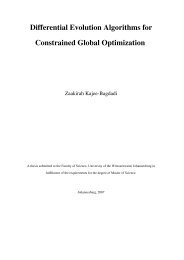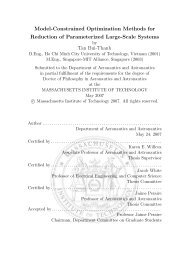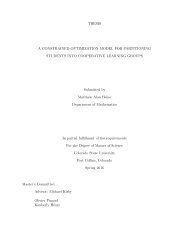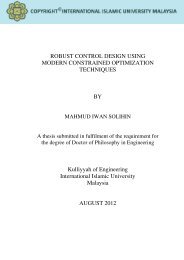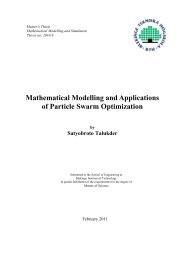Constrained Optimization
Create successful ePaper yourself
Turn your PDF publications into a flip-book with our unique Google optimized e-Paper software.
<strong>Constrained</strong> <strong>Optimization</strong>: Step by Step<br />
Most (if not all) economic decisions are the result of an optimization problem<br />
subject to one or a series of constraints:<br />
• Consumers make decisions on what to buy constrained by the fact that<br />
their choice must be affordable.<br />
• Firms make production decisions to maximize their profits subject to<br />
the constraint that they have limited production capacity.<br />
• Households make decisions on how much to work/play with the<br />
constraint that there are only so many hours in the day.<br />
• Firms minimize costs subject to the constraint that they have orders to<br />
fulfill.<br />
All of these problem fall under the category of constrained optimization. Luckily,<br />
there is a uniform process that we can use to solve these problems. Here’s a<br />
guide to help you out.<br />
Maximizing Subject to a set of constraints:<br />
max<br />
x,<br />
y<br />
f<br />
( x,<br />
y)<br />
subject to<br />
g<br />
( x, y)<br />
≥ 0<br />
Step I: Set up the problem<br />
Here’s the hard part. We always want the problem structured in a<br />
particular way. Here, we are choosing to maximize f ( x, y)<br />
by choice of x and y .<br />
The function g ( x, y)<br />
represents a restriction or series of restrictions on our<br />
possible actions.<br />
The setup for this problem is written as<br />
l<br />
( x , y) = f ( x,<br />
y) + λg( x,<br />
y)<br />
For example, a common economic problem is the consumer choice decision.<br />
Households are selecting consumption of various goods. However, consumers are<br />
not allowed to spend more than their income (otherwise they would buy infinite<br />
amounts of everything!!). Let’s set up the consumer’s problem:
Suppose that consumers are choosing between Apples (A) and Bananas (B). We<br />
have a utility function that describes levels of utility for every combination of<br />
Apples and Bananas.<br />
1<br />
2<br />
1<br />
2<br />
A B = Well being from consuming (A) Apples and (B) Bananas.<br />
Next we need a set pf prices. Suppose that Apples cost $4 apiece and Bananas<br />
cost $2 apiece. Further, assume that this consumer has $120 available to spend.<br />
They the income constraint is<br />
$ 2B<br />
+ $4A<br />
≤ $120<br />
( ) 0<br />
However, they problem requires that the constraint be in the form g x, y ≥ . In<br />
the above expression, subtract $2B and $4A from both sides. Now we have<br />
0 ≤ $120 − $2B − $ 4A<br />
g ( A,<br />
B)<br />
Now, we can write out the lagrangian<br />
1 1<br />
l<br />
2 2<br />
( A, B)=<br />
A B + λ ( 120 − 2B − 4A)<br />
f ( A, B)<br />
g ( A,<br />
B)<br />
Step II: Take the partial derivative with respect to each variable<br />
We have a function of two variables that we wish to maximize. Therefore, there will be<br />
two first order conditions (two partial derivatives that are set equal to zero).<br />
In this case, our function is<br />
1 1<br />
l<br />
2 2<br />
( A, B)=<br />
A B + λ ( 120 − 2B − 4A)<br />
Take the derivative with respect to A (treating B as a constant) and then take the<br />
derivative with respect to B (treating A as a constant).
l<br />
l<br />
B<br />
( A,<br />
B)<br />
A<br />
=<br />
1<br />
2<br />
1<br />
2<br />
A<br />
1<br />
−<br />
2<br />
1<br />
2<br />
B<br />
1<br />
2<br />
− 4λ<br />
= 0<br />
−<br />
2<br />
( A,<br />
B) = A B − 2λ<br />
= 0<br />
III: Solve the First order conditions for lambda<br />
1<br />
If we solve the above two equations for λ we get<br />
λ =<br />
λ =<br />
1<br />
−<br />
1<br />
2<br />
A B<br />
4<br />
1<br />
2<br />
2<br />
A B<br />
8<br />
1<br />
−<br />
2<br />
IV: Set the two expressions for lambda equal to each other<br />
1<br />
−<br />
1<br />
2<br />
2<br />
A B<br />
8<br />
=<br />
1<br />
2<br />
A B<br />
4<br />
1<br />
−<br />
2<br />
If we simplify this down a bit:<br />
1<br />
−<br />
1<br />
2<br />
2<br />
A B<br />
8<br />
=<br />
1<br />
2<br />
A B<br />
4<br />
1<br />
−<br />
2<br />
(Multiply both sides by 8)<br />
1<br />
1<br />
2<br />
1 1<br />
−<br />
2 2<br />
8<br />
− A B<br />
2<br />
2<br />
A B =<br />
(Divide both sides by B )<br />
4<br />
1<br />
−<br />
1<br />
−<br />
2<br />
A B =<br />
8 2 1<br />
A<br />
4<br />
1<br />
−<br />
2<br />
(Divide both sides by A )<br />
8A<br />
B = (simplify)<br />
4<br />
B = 2A
This tells us that if we are acting optimally, we should always buy twice as many bananas<br />
as apples (which makes sense because they cost twice as much!). At this step, we should<br />
always have an expression that relates one variable to the other.<br />
V: Use the constraint to solve for the two variables separately<br />
Next, notice that the income constraint will always be met with equality (utility always<br />
increases as we buy more and more). Therefore, we know<br />
2 B + 4A<br />
= 120<br />
We can use these to solve the rest of the problem.<br />
B = 2A<br />
2 (2A)<br />
+ 4A<br />
= 120 ⇒ 8A<br />
= 120 ⇒ A = 15<br />
2 B + 4A<br />
= 120<br />
We now know that we will buy 15 Apples and 30 Bananas (B = 2A). Notice that the<br />
income constraint is satisfied.<br />
$ 2(30) + $4(15) = $120<br />
Minimizing Subject to a set of constraints:<br />
min<br />
f<br />
( x,<br />
y)<br />
x , y<br />
to g ≥<br />
subject<br />
( x, y)<br />
0<br />
Step I: Set up the problem<br />
This basically works the same way as the problem above. Here, we are choosing to<br />
minimize f ( x, y) by choice of x and y . The function g ( x, y)<br />
represents a restriction or<br />
series of restrictions on our possible actions.<br />
The setup for this problem is written as<br />
l<br />
( x , y) = f ( x,<br />
y) − λg( x,<br />
y)
Note that the setup is identical with the exception that the second term in the above<br />
expression is being subtracted rather than added.<br />
The usual problem is a firm trying to minimize costs subject to the requirement that it<br />
must produce a certain amount of output.<br />
Suppose that a firm is choosing levels of labor and capital (L and K). Output is produced<br />
according to the following process<br />
1<br />
2<br />
1<br />
2<br />
K L = Firm Output (I chose the same function as above to simplify things)<br />
Next we need a set of prices. Suppose that units of capital cost $3 apiece and hours of<br />
labor cost $9. We can write out total costs for the firm as the sum of capital costs and<br />
labor costs.<br />
Total Costs = $ 3K<br />
+ $ 9L<br />
The firm wants to minimize the total costs of producing (at least) 100 units of output.<br />
K<br />
1<br />
2<br />
L<br />
1<br />
2<br />
≥ 100<br />
Therefore, the problem we face is<br />
min<br />
x,<br />
y<br />
{ 3K<br />
+ 9L}<br />
subject to<br />
K<br />
1<br />
2<br />
L<br />
1<br />
2<br />
≥ 100<br />
Again, the problem requires that the constraint be in the form g<br />
above expression, subtract 100 from both sides. Now we have<br />
K<br />
1<br />
2<br />
L<br />
1<br />
2<br />
g ( K,<br />
L)<br />
−100<br />
≥ 0<br />
( x, y) ≥ 0<br />
. In the<br />
We can write the problem as<br />
l<br />
( ) ⎜ 2<br />
x, y = 3K<br />
+ 9L<br />
− λ<br />
K L −100<br />
⎟ ⎝ ⎠<br />
⎛<br />
1<br />
2<br />
1<br />
⎞
Again, note that the setup is identical with the exception that the second term in the<br />
above expression is being subtracted rather than added.<br />
Step II: Take the partial derivative with respect to each variable<br />
We have a function of two variables that we wish to maximize. Therefore, there will be<br />
two first order conditions (two partial derivatives that are set equal to zero).<br />
In this case, our function is<br />
l<br />
( ) ⎜ 2<br />
x, y = 3K<br />
+ 9L<br />
− λ<br />
K L −100<br />
⎟ ⎝ ⎠<br />
Take the derivative with respect to A (treating B as a constant) and then take the<br />
derivative with respect to B (treating A as a constant).<br />
l<br />
K<br />
( A,<br />
B)<br />
1 1<br />
⎛ 1 ⎞<br />
2<br />
l<br />
L<br />
⎜ 2 ⎟<br />
⎝ ⎠<br />
III: Solve the First order conditions for lambda<br />
⎛<br />
⎛ 1<br />
= 3 − λ⎜<br />
K<br />
⎝ 2<br />
1<br />
−<br />
2<br />
1<br />
2<br />
1<br />
2<br />
−<br />
2<br />
( K,<br />
L) = 9 − λ⎜<br />
K L ⎟ = 0<br />
L<br />
1<br />
⎞<br />
⎟<br />
= 0<br />
⎠<br />
⎞<br />
If we solve the above two equations for λ we get<br />
λ =<br />
λ =<br />
1<br />
2<br />
1<br />
2<br />
K<br />
K<br />
3<br />
1<br />
−<br />
2<br />
9<br />
1<br />
2<br />
IV: Set the two expressions for lambda equal to each other<br />
L<br />
L<br />
1<br />
2<br />
1<br />
−<br />
2<br />
1<br />
2<br />
K<br />
3<br />
1<br />
−<br />
2<br />
L<br />
1<br />
2<br />
=<br />
1<br />
2<br />
K<br />
9<br />
1<br />
2<br />
L<br />
1<br />
−<br />
2
If we simplify this down a bit:<br />
1<br />
2<br />
K<br />
3<br />
1<br />
−<br />
2<br />
L<br />
1<br />
2<br />
=<br />
1<br />
2<br />
K<br />
9<br />
1<br />
2<br />
L<br />
1<br />
−<br />
2<br />
(Cancel out the 1/2s and divide both sides by 3)<br />
K<br />
1<br />
1<br />
−<br />
2<br />
L<br />
1<br />
2<br />
=<br />
3K<br />
9<br />
1<br />
2<br />
L<br />
1<br />
−<br />
2<br />
1<br />
2<br />
(Multiply both sides by K )<br />
K<br />
L<br />
1<br />
2<br />
=<br />
9<br />
3L<br />
1<br />
−<br />
2<br />
1<br />
−<br />
2<br />
(Multiply both sides by L )<br />
K<br />
L<br />
9<br />
=<br />
3<br />
(simplify)<br />
K<br />
L<br />
= 3<br />
This tells us that if we are acting optimally, we should always employ three times as<br />
much capital as labor (which makes sense because labor costs three times as much!). At<br />
this step, we should always have an expression that relates one variable to the other.<br />
V: Use the constraint to solve for the two variables separately<br />
Next, notice that the production constraint will always be met with equality (your costs<br />
will always go down if you produce less). Therefore, we know<br />
K<br />
1<br />
2<br />
L<br />
1<br />
2<br />
= 100<br />
We can use these to solve the rest of the problem.<br />
K<br />
K = 3L<br />
1<br />
2<br />
L<br />
1<br />
2<br />
= 100<br />
1<br />
2<br />
1<br />
2<br />
100<br />
() 3 L = 100 ⇒ = = 57. 8<br />
( 3L<br />
) L = 100 ⇒ 2 L<br />
1<br />
3<br />
Therefore, L = 57.8, K = 3L = 173.41, and (if you check, total production does equal 100)



